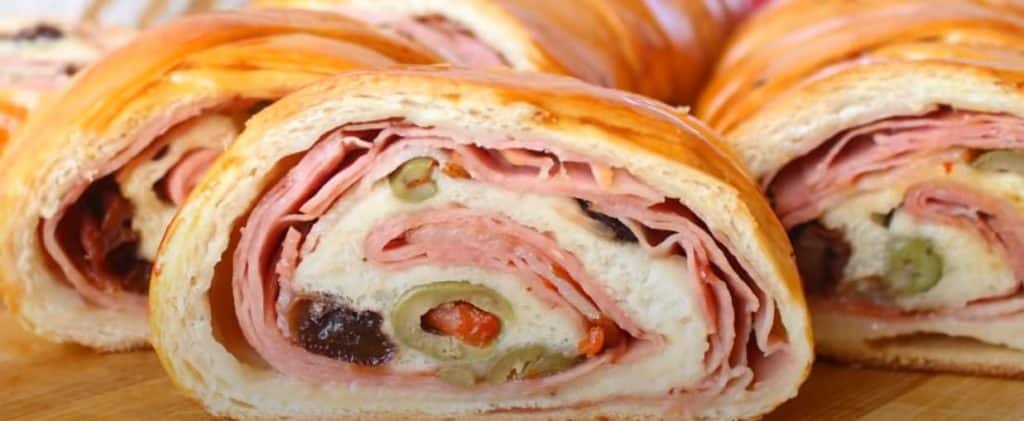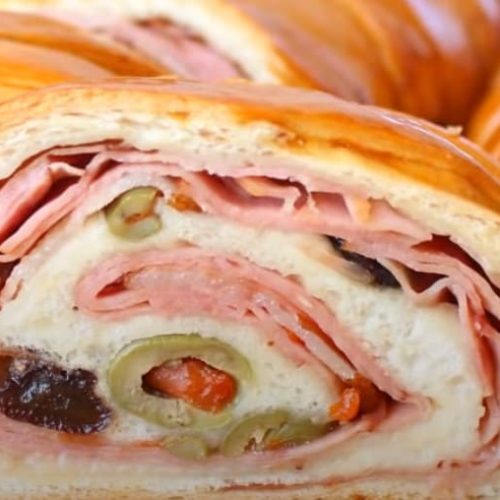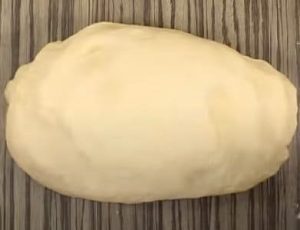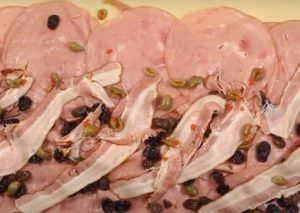The Delicious World of Venezuelan Pan de Jamón: Tradition and Flavor
Do you want to delight yourself with the irresistible taste of Venezuelan Pan de Jamón? Discover the secret recipe that will make you feel like Christmas at any time of the year. With its combination of smoked ham, bacon, raisins and olives, each bite will transport you to tradition and family love. Get ready to enjoy a feast of unique flavors!

Aperitivos Venezolanos, Bollos Pelones, Tequeños, Patacones, Asado Negro, Pabellón Criollo
Pan de Jamón is one of Venezuela's most emblematic culinary treasures. With its unique combination of ingredients and flavors, this stuffed bread has become a must-have tradition during the holiday season. From its soft, fluffy dough to its juicy and flavorful filling, Pan de Jamón is a delight that brings Venezuelan families together around the table. In this article, we will explore every aspect of this delicacy, from the basic recipe to tips on how to achieve a perfect result at home.
- What is Pan de Jamón?
- Preparing the Perfect Dough
- The Filler That Makes the Difference
- The Art of Rolling and Filling
- Baking and Seductive Aromas
- The Final Touch: Varnishing and Shining
- How to make Ham Bread at home
- Christmas Pan de Jamón Recipe - quearepas.com
- Serving and Sharing the Ham Bread
- Innovation and Variants of the Classic
- History and Cultural Significance of Venezuelan Ham Bread
- Frequently Asked Questions
What is Pan de Jamón?
Pan de Jamón is an emblematic and traditional dish of Venezuelan gastronomy. It is a stuffed bread, similar to a roll, containing a combination of ingredients including smoked ham, bacon, raisins and stuffed olives. This delicacy is especially popular during the Christmas season in Venezuela and has become an integral part of the holiday festivities.
Pan de Jamón dough is soft and fluffy, similar to bread dough, and is rolled around the filling before being baked. The filling itself is what sets Pan de Jamón apart, as the combination of salty, sweet and smoky flavors creates a unique culinary experience.
Pan de Jamón can be enjoyed with Papelón con Limón or a delicious Venezuelan Chicha.
Preparing the Perfect Dough
The Art of Selecting Baking Wheat Flour
The choice of baker's wheat flour is crucial to achieve the characteristic texture of Ham Bread. This flour is different from regular flour, as it has a higher protein content, resulting in a more elastic dough with a greater capacity to retain the gas produced by the yeast. When looking for baker's wheat flour, it is advisable to opt for a quality brand to guarantee an optimal result.
Step by Step: Mixing, Kneading and Resting the Dough
Preparing the dough for the Pan de Jamón is a process that requires patience and precision. Start by mixing the flour with salt and sugar in a large bowl. Dissolve the yeast in warm water and add it to the mixture, along with the margarine and egg. Begin kneading the dough on a lightly floured surface until smooth and elastic. Kneading not only combines the ingredients, but also activates the gluten in the flour, which contributes to the final structure of the bread.
After kneading, give the dough adequate time to rest and rise. Cover the bowl with a damp cloth and leave it in a warm place for about an hour, or until the dough doubles in size. This process allows the yeast to do its work, releasing gases that make the dough airy and light.
The Importance of Yeast in Bread Texture and Flavor
Yeast is the engine behind the magic of fermentation in the preparation of Ham Bread. As the yeast consumes the sugars present in the dough, it releases carbon dioxide, creating air bubbles that cause the dough to rise. This process is essential to achieve the bread's spongy texture. In addition, yeast contributes to the development of flavors in the dough, providing subtle nuances that are enhanced during baking.
It is important to handle the yeast carefully, making sure it is active before mixing it with the other ingredients. This can be done by dissolving the yeast in warm water and letting it sit for a few minutes until it becomes foamy. Once active, add the yeast to the dough and follow the time and rest instructions to allow it to do its work of fermentation effectively.
Remember that Christmas is the time to enjoy a delicious Dulce de Lechoza and don't forget to try the Ponche Crema.
The Filler That Makes the Difference
The filling of the Pan de Jamón is what really distinguishes this delicious culinary creation. Each ingredient contributes a unique flavor and texture, creating a harmonious combination that is the basis of this dish's unmistakable character. Here are the key elements that make the Pan de Jamón filling truly special:
Smoked Ham: Choosing the Right Quality and the Right Cut
Smoked ham is the heart of the Pan de Jamón filling, and the choice of quality is essential to achieve an exceptional flavor. Opt for an excellent quality smoked ham, preferably in its lean version, which will provide an intense and salty flavor. The ham should be cut into thin strips so that it is evenly distributed throughout the bread. The juiciness and texture of this ingredient are crucial to balance the flavors and achieve an unforgettable taste experience.
Crispy Bacon for a Contrast of Textures
Bacon adds a crucial component to the Pan de Jamón filling: a textural contrast. The bacon is cooked until crispy and golden brown, providing a salty flavor and crunchy texture that complements the softness of the ham. This contrast of textures is one of the aspects that makes each bite interesting and delicious. Be sure to drain the cooked bacon well to prevent excess fat from affecting the consistency of the bread.
Stuffed Raisins and Olives: A Sweet and Sour and Salty Touch
The raisins and stuffed olives add a play of sweet and sour and salty flavors to the Pan de Jamón filling. The raisins add sweetness and a fruity touch that contrasts with the intensity of the salty flavors of the other ingredients. On the other hand, the paprika-stuffed olives add a salty, smoky flavor that blends perfectly with the ham and bacon. The combination of these ingredients creates a balance of flavors that make each serving a complete and satisfying taste experience.
We recommend you try the delicious Quesillo and Torta Negra.
The Art of Rolling and Filling
The process of rolling and stuffing the Pan de Jamón is one of the most crucial steps to ensure its final appearance and flavor. Each step must be performed with precision to achieve a uniformly filled and delicious loaf. Here I will guide you through the essential techniques to achieve a perfectly rolled and stuffed Ham Bread:
Techniques for Spreading the Dough Uniformly
To begin, make sure the dough has leavened properly and is of a size that allows you to work with it comfortably. Roll out the dough on a lightly floured surface into a rectangle. Use a rolling pin to roll it out evenly, maintaining the desired thickness for the bread. Work from the center to the edges to prevent the dough from breaking.
Strategic Ingredient Allocation for Each Bite
Proper distribution of ingredients is essential to ensure that each slice of bread has a balance of flavors and textures. Start by evenly distributing the ham strips over the rolled out dough. Next, place the crispy bacon, raisins and stuffed olives, making sure they are evenly dispersed across the entire surface. This strategic distribution ensures that each bite is a complete taste experience.
How to Achieve a Tight Roll and Avoid Overflows During Baking
Rolling the Pan de Jamón tightly is crucial to prevent the filling from sliding out during baking. Start by rolling the dough from one of the long edges, applying light pressure to hold the ingredients in place. As you roll, keep the filling compact, but avoid over-tightening to prevent the ingredients from escaping.
Once you have finished rolling, place the bread on a baking sheet with the seam side down. You can make small diagonal incisions in the top to allow steam to escape and prevent the bread from opening during baking.
If you're worried about overflow, you can fold the ends in before baking to seal the edges and keep the filling in place. Also, be sure to follow the baking time and temperature directions to get a crispy golden crust without the filling overflowing.
Baking and Seductive Aromas
Baking Tips for a Golden Crust and Crispy Crust
Baking is the highlight of creating Pan de Jamón Venezolano. To achieve a golden, crispy crust that encases the fluffy treat inside, follow these key tips. Preheat the oven to the temperature indicated in your recipe. Make sure the oven is very hot before placing the bread in the oven to ensure even baking.
Place the bread in the middle part of the oven so that it receives even heat. During the first few minutes of baking, a touch of steam can be beneficial for a crispier crust. Spray water inside the oven or place a pan of hot water in the bottom. Don't forget to make small incisions in the top of the bread to allow steam to escape and prevent the bread from splitting open during baking.
The Irresistible Aroma That Fills the Kitchen While Baking
The baking process of Pan de Jamón not only creates a golden, crispy crust, but also fills the kitchen with a seductive aroma that is characteristic of this delicacy. As the ingredients cook and mix, the flavors intensify and the aromas are released, creating an irresistible fragrance that instantly transports you to the holiday season in Venezuela. The combination of ham, bacon, raisins and other ingredients creates a unique and comforting scent that heightens the anticipation of savoring the freshly baked bread.
Knowing When Bread is Ready: Texture and Sound to Watch Out For
Knowing when Ham Bread is ready is a skill that develops with experience and practice. A key indicator is the crisp, golden crust that forms on the top. Also, lightly tap the bottom of the loaf; if it sounds hollow, it's a sign that the bread is fully cooked. Another way to check for doneness is to insert a thermometer into the center of the loaf; it should register an internal temperature of about 375°F (190°C).
The Final Touch: Varnishing and Shining
The Sugar and Water Mixture for the Characteristic Varnish
Glazing is the final touch that enhances the presentation and flavor of the Pan de Jamón. The mixture of sugar and water creates an attractive shine on the surface of the bread, in addition to providing a sweet flavor that contrasts with the intensity of the salty and smoky flavors of the filling. Mix sugar with a splash of water in a small bowl until it dissolves completely and you obtain a homogeneous mixture.
How to Apply Varnish for a Glossy and Appetising Finish
After baking and while the bread is still warm, apply the glaze evenly over the surface with a kitchen brush. As the bread absorbs the glaze, it will take on a seductive shine that invites you to taste it. This step also helps to seal the crust slightly, keeping the bread fresh longer.
The Visual and Gustative Contrast that Varnishing Brings to Bread
The glaze not only adds visual brilliance to the Ham Bread, but also brings a flavor contrast with its sweetness. When you bite into a slice of bread with the varnished crust, you will experience an explosion of flavors: the salty taste of the filling merges with the sweetness of the varnish, creating a taste harmony that is the perfect culmination of this culinary masterpiece.
How to make Ham Bread at home
Discover how to create the delicious Pan de Jamón at home, a Venezuelan tradition that combines fluffy dough and tasty filling. Follow the step by step of this recipe, thanks to ChefTurista and her recipe channel.

Christmas Pan de Jamón Recipe - quearepas.com
Ingredients
For the Dough:
- 830 gr Bread wheat flour
- 260 ml Water
- 60 gr Sugar
- 100 gr Margarine
- 1 unit Egg
- 10 gr Salt
- 8 gr Yeast
For the Filling:
- 1200 gr Smoked ham of excellent quality
- 200 gr Tocineta (bacon)
- 190 gr Raisins
- 190 gr Olives stuffed with paprika
For Varnishing:
- 1/4 cup Water
- 1/4 cup Sugar
- 1 unit Egg
Instructions
Dough Preparation:
- In a large bowl, mix the flour with the sugar and salt. Dissolve the yeast in the warm water and let it stand for a few minutes until it becomes foamy. Add the activated yeast, melted margarine and egg to the flour mixture.
- Start kneading the dough on a floured surface until you obtain a smooth and elastic dough. This may take about 10-15 minutes of kneading.
- Place the dough in a bowl, cover it with a damp cloth and let it rest in a warm place for about 1 hour, or until the dough has doubled in size.
Filling Preparation:
- Roll out the dough on a floured surface into a rectangle.Evenly distribute the ham strips over the dough.Add the bacon, raisins and paprika-stuffed olives, making sure they are distributed over the entire surface.
Winding and Forming:
- Begin rolling the dough from one of the long edges, applying light pressure to keep the ingredients in place.Once rolled, place the loaf on a baking sheet with the seam side down.Make small diagonal incisions in the top to allow steam to escape during baking.
Baking:
- Preheat the oven to 180°C (350°F).Bake the bread in the preheated oven for approximately 30-40 minutes, or until golden brown and cooked through in the center. You can check for doneness by lightly tapping the bottom of the loaf; if it sounds hollow, it is done.
Varnishing:
- While the bread is still warm, mix the sugar and water to create the glaze.Apply the glaze evenly over the surface of the bread using a kitchen brush.
Chilled and Served:
- Let the Pan de Jamón cool before slicing.Serve the slices in an attractive presentation and enjoy this delicious Venezuelan delicacy.
Video
Notes
Nutritional Information
Typical Serving: 1 slice (approximately 50 g) Approximate Nutritional Value of a Serving:- Calories: 180-220 kcal
- Fat: 6-8 g
- Saturated Fat: 2-3 g
- Cholesterol: 15-25 mg
- Sodium: 400-600 mg
- Carbohydrates: 24-28 g
- Dietary fiber: 1-2 g
- Sugars: 4-6 g
- Protein: 6-8 g
Serving and Sharing the Ham Bread
Slicing and Presenting Bread in an Attractive Way
The timing of slicing and presentation of the Pan de Jamón is crucial to enhance its appearance and enjoyment. Use a sharp knife to make uniform slices. You can choose to cut the bread into thin slices or more generous portions, depending on your preferences and the occasion. A traditional way to present the bread is in the shape of a fan, arranging the slices overlapping to highlight the colors and textures of the filling. You can also accompany the bread with sprigs of green leaves to add a touch of freshness to the presentation.
Traditional Accompaniments that Enhance your Flavor
Pan de Jamón can be enjoyed alone or accompanied by ingredients that enhance its flavor. The traditional combination of fresh white cheese and butter is a popular choice. The white cheese provides a refreshing contrast to the intense flavors of the bread, while the butter adds a smooth texture and creamy flavor that complements the filling. In addition, you can accompany the bread with freshly brewed coffee, hot chocolate or typical holiday beverages, such as cream punch.
Sharing the Tradition: Giving and Enjoying Ham Bread in Community
Ham Bread is not only a delicious culinary creation, but also a symbol of togetherness and generosity. A beautiful tradition is to give Pan de Jamón to friends, neighbors and loved ones during the holiday season. Carefully package a portion in cellophane or festive wrapping paper and share this treat with others. By doing so, you not only share the flavor, but also the Christmas spirit and Venezuelan culture.
Sharing and enjoying Pan de Jamón as a community creates special moments and brings people together around a shared tradition. Invite family and friends to your table to enjoy this iconic dish together and create lasting memories around food and fellowship.
Innovation and Variants of the Classic
Modern Interpretations: Alternative Ingredients and Healthy Choices
The versatility of Pan de Jamón has led to the creation of modern interpretations that incorporate alternative ingredients and healthier options. You can experiment with lighter versions by using whole-grain flours or gluten-free alternatives for the dough. In addition, you can choose lean ham and bacon to reduce the fat and caloric content of the filling. Incorporating spinach, broccoli or other vegetables also adds a touch of freshness and nutrition to the bread.
Creative Fusions that Maintain the Essence of Ham Bread
The essence of Pan de Jamón can remain intact even when fused with other ingredients and culinary cultures. For example, you can create a Mediterranean-inspired version by adding feta cheese and kalamata olives to the filling. Or, for a tropical twist, consider incorporating pineapple or mango chunks. The key is to maintain a balance of flavors and textures so that the essence of Pan de Jamón remains recognizable.
Ham Bread: Beyond Christmas, Incorporating it into Everyday Cooking
Although Pan de Jamón is a holiday tradition, its flavor and versatility can take it beyond the festive season. You can adapt the filling concept and rolling technique to create smaller versions that work as appetizers any time of year. Plus, leftover Ham Bread is perfect for making delicious sandwiches that add a festive touch to your everyday lunch.
History and Cultural Significance of Venezuelan Ham Bread
Historical Origins and Evolution of the Recipe
The origin of Pan de Jamón dates back to the middle of the 20th century in Venezuela. Its creation is attributed to the renowned chef and businesswoman from Caracas, Gladys Abou de Méndez. In the 1940s, inspired by French cuisine and seeking to innovate Venezuelan Christmas dishes, Gladys fused local elements with European techniques to give life to this delicious creation.
The original recipe for Pan de Jamón included smoked ham, bacon, stuffed olives and raisins, all wrapped in a soft and spongy dough. Over time, this recipe has been adapted and customized in different regions of Venezuela, giving rise to variations that incorporate local and traditional ingredients.
The Role of Ham Bread in Holiday and Other Celebrations
Pan de Jamón is not just another dish on the Venezuelan Christmas table; it is a symbol of celebration, union and generosity. Its presence in the Christmas festivities is almost as important as the Christmas tree. This stuffed bread has become an essential element in family meals and gatherings during the Christmas season, and its preparation is often an event that involves several generations.
The tradition of Pan de Jamón has also transcended Venezuela's borders and has become a characteristic gift among friends and co-workers during the holiday season. In addition to Christmas, Pan de Jamón is also enjoyed at other celebrations, such as weddings, birthdays and special events. Its unique flavor and ability to bring people together has made it a culinary icon that transcends cultural boundaries.
We suggest you to see more Venezuelan food recipes.
Frequently Asked Questions
What ingredients are needed to make Pan de Jamón?
The main ingredients are wheat flour, smoked ham of excellent quality, bacon, raisins and olives stuffed with paprika. Other ingredients such as water, sugar, margarine, egg, salt and yeast are also used.
Can I make gluten-free Pan de Jamón?
Yes, it is possible to adapt the recipe using gluten-free wheat flour or commercially available gluten-free flour blends. Be sure to follow the directions for use for each type of flour and adjust the proportions as needed.
What is the best way to preserve Pan de Jamón?
To preserve the Ham Bread, it is recommended to wrap it in aluminum foil or plastic wrap and store it in the refrigerator. You can also freeze it in individual portions to enjoy it later. At the moment of consumption, you can heat it slightly in the oven to recover its texture and flavor.
What is the tradition of consumption of Pan de Jamón in Venezuela?
In Venezuela, Pan de Jamón is very popular during the Christmas holidays. It is usually shared at family gatherings and parties, and is an important part of Christmas Eve dinner. It can also be enjoyed throughout the year in Venezuelan bakeries and pastry shops.
If you want to know other articles similar to The Delicious World of Venezuelan Pan de Jamón: Tradition and Flavor you can visit the category Comida Venezolana.






